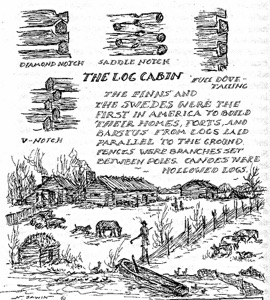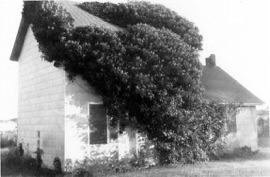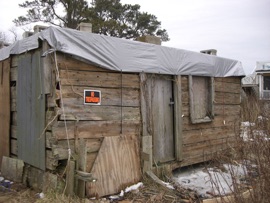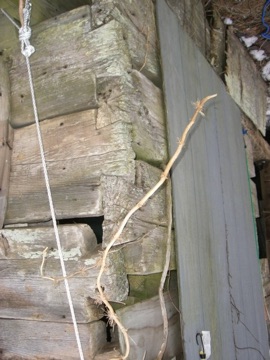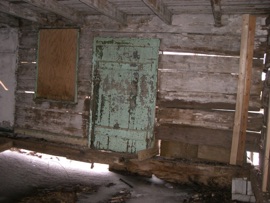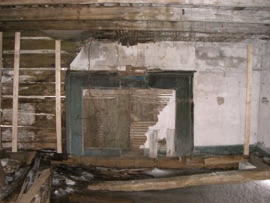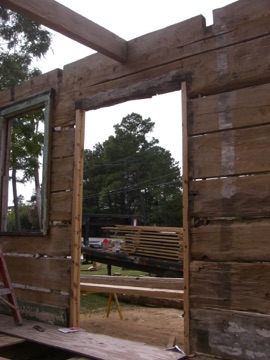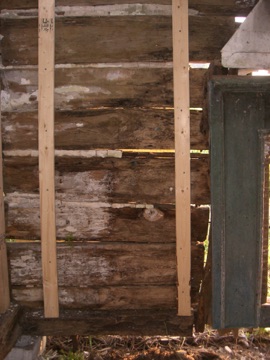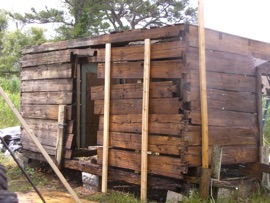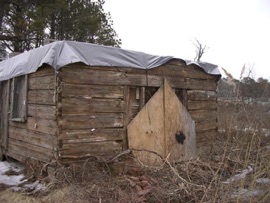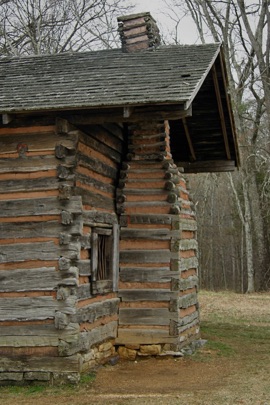Architectural History...continued....
This meant in order to move the house they needed to know something about log buildings. Other aspects of the building caught their attention and made it clear they needed to really understand the architectural history of this house. This led them to seek help from The Virginia Department of Historic Resources and then to Carl Lounsbury, architectural historian at The Colonial Williamsburg Foundation. They learned that the house was built about 1800 and that the logs were hewn and pit sawn into planks then tightly joined at the corners with full dovetail joints also known as notches. (Photo 2 in Slideshow.) This was a style of architecture brought to the New World in 1638 when the Finns and the Swedes sailed up the Delaware Bay and settled what is now Wilmington, Delaware. This style was adopted by other immigrant groups as they found a new land of tall trees and a way to build a house with just an ax and a saw. (Photo 3 in Slideshow.) It proved warm in the winter and cool in the summer. Most were built like the Hill House with one room down and one up and with a staircase or ladder to connect the floors. A fireplace opening was placed either on a gable end or a corner depending on what local customs you brought with you from your homeland. Although a once common style of house for the early colonists in the mid-Atlantic and south, very few of these buildings have survived from those early days...mostly in Delaware, Pennsylvania, and New Jersey. (Photo 4 in Slideshow.)
That the Hill House endured the coastal climate for more than two centuries is a miracle in itself but it also survived threatened destruction of the human kind. The house originally was situated on the east side of the island and the land it sat on was sold in 1980. The new owner wanted to clear that land and build a new, modern house. Thankfully, Richard Vesely had been hired as the architect for the new house. He knew that this old building was of historical interest so he took it upon himself to move it to safety when his client said she just might burn it down. So, it was moved to the west side of the island and there it sat at this temporary location for many years...the Town threatening to tear it down from time to time but then...new life for an old house. (Photo 5 in Slideshow.)
In early 2010, Mr. Lounsbury came with colleague Jeff Klee to inspect the structure and were quite amazed by what they found. (Photo 6 in Slideshow.) There was a great deal of original material left. All the log walls were intact. The dovetail joints have little damage to the edges which indicates the house was never taken apart. The single pen house measures 17’4” by 16’4”. It was built to have two doors, a small window on the north gable end and a fireplace opening on the south wall. They knew this because all of these openings were defined by pins, about 6” long and about 3/4” in diameter, set in between the top of one log and the bottom of the next. These pins would have kept the logs stable at the openings while the house was built....log upon log. The planks were about 3” thick and 10” in height. Evidence remained of wood chinking and a lime based daubing filled with bits of oyster shells and animal and human hair that filled the spaces between the logs. (Photos 7-10 in Slideshow.)
Shadows and nailings at the interior SE corner defined the outlines of the enclosed staircase. The original staircase door had survived. The mantel surround was intact. The original batten door with layers of paint still hung on the west door opening....the original east door was no longer there as the opening had been enlarged at some time in the late 19th or early 20th Century. (Photo 11 in Slideshow.)
There were window openings on the east and west walls for six over six windows but no pins defined these openings so they likely were cut in later. There was early trim work around these windows and the surviving door. A door opening had been cut in the north wall to connect a later frame addition. The early pin evidence of the window on the north wall still existed so the dimensions of the early window could be defined. However, any changes that might have occurred to that window were lost when the door opening was cut in. (Photo 12 in Slideshow.)
The biggest and most important surprise was found when exploring the exterior of the south wall. There were mortise holes above the fireplace opening. These mortise holes made it clear this house was originally built to have a wooden chimney! Lounsbury and Klee were very excited to find this evidence. It meant this house was indeed a rare piece of architecture. It turns out that the Hill House is one of only two buildings that have survived in Virginia that were originally built with this kind of chimney. Wooden chimneys were very prevalent. Brick was expensive...it had to be made. Trees were plentiful. So, the most expedient way to make a chimney was to build a wooden structure and cover the inside with a clay like plaster to protect the interior of the firebox. The stack was usually woven of sticks with a clay mud chinking. This kind of chimney was often referred to as a “catted” chimney and were much more common than we might imagine today. (Photos 13-16 in Slideshow.)
